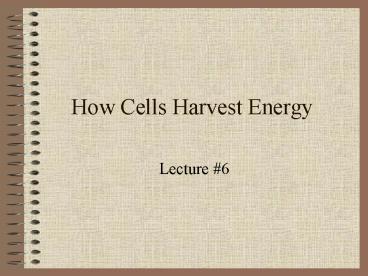How Cells Harvest Energy
1 / 55
Title: How Cells Harvest Energy
1
How Cells Harvest Energy
- Lecture 6
2
(No Transcript)
3
Autotrophs
- producers of the world
- Can convert radiant energy (sun) to chemical
energy - Plants, algae and some bacteria (cyanobacteria)
- Photosynthesis
4
Heterotrophs
- eaters of the world
- Lack the ability to directly absorb radiant
energy - Must rely on autotrophs for their energy input
- 95 of all living species are heterotrophs.
5
Energy Transfer
- Autotrophs Heterotrophs
6
Autotrophs
- Capture radiant energy into
- Sugars carbohydrates (CHO)
- Amino acids proteins (PRO)
- Fatty acids lipids (FAT)
- So, what happens when a heterotroph eats an
autotroph?
7
Heterotroph
- Break down complex molecules into
subunits.digestion - Then break down subunits to release
energy.catabolism - CHO sugars energy
- PRO amino acids energy
- FAT fatty acids energy
8
Catabolism
- Hydrogen 1 proton (H) 1 electron (e-)
- Energyfollow the electron
- Electrons are passed on to electron acceptors
such as NAD - The H (proton) is passed on to one of two
recipients - Oxygen.oxidative respiration (aerobic)
- Organic molecules.fermentation (anaerobic)
9
Oxidative Respiration
10
Oxidative Respiration
- Catabolism of glucose into CO2 and H2O with the
release of energy - C6H12O6 6O2 6CO2 6H2O
- energy
- ATP
HEAT
11
- So.how is the energy released from glucose?
- Gas tank.quick or in smaller events?
- Catabolism of glucose (and harvesting of
energy).four stage process
12
CATabolism
13
Four Stages
- Glycolysis
- Pyruvate oxidation
- The Krebs cycle
- Electron transport chain
- C6H12O6 6O2 6CO2 6H2O
- energy
14
Mitochondrion
15
Cell Location of Each Stage
- Stage 1 in cytoplasm
- Stages 2 3 4 within mitochondria
16
Overview of Aerobic Respiration
17
Stage 1 -- Glycolysis
- Glucose (6 C) 2 Pyruvate (3C)
- 10 reaction process
- Occurs in the cytoplasm of the cell
18
Glycolysis (Rx 1 6)
19
Glycolysis (Rx 7 10)
20
Three Steps
- Glucose priming
- Requires 2 ATP
- 6 C 6C PP
- (glucose) (fructose 1,6-bisphosphate)
21
Overview of Glycolysis
22
Three Steps
- Cleavage
- 6 C PP 2 X 3C P
- (glyceraldehyde-3-phosph
ate)
23
Overview of Glycolysis
24
Three Steps
- Generation of Energy Molecules
- 2 X 3C P 3C
- (pyruvate)
- Production of 2 NADH and 4 ATP (-2ATP for priming
of glucose)
25
Overview of Glycolysis
26
Summary of Glycolysis
- Glucose (6C) 2 X Pyruvate (3C)
- 10 step process (in cytoplasm)
- Yields 2 NADH and 2 ATP
- Takes place in the absence of O2
- All cells use glycolysis (prokaryote and
eukaryote). - Probably one of the earliest biochemical
reactions to evolve.
27
Stage 2-Oxidation of Pyruvate
- Takes place in the mitochondria
- Oxygen is used
- Pyruvate was generated in cytoplasm, then
transported into mitochondria.
28
Stage 2Oxidation of Pyruvate
- Pyruvate O2 Acetyl CoA CO2
- (3C) (2C)
(1C) - Acetyl CoA Acetyl-CoA (2C)
- NADH
- Pyruvate O2 Acetyl-CoA CO2
- NADH
29
Acetyl-CoA
30
Review
- Stage 1 glycolysis
- glucose pyruvate
- 6C 2 X 3C 2NADH 2ATP
- 2. Stage 2 oxidation of pyruvate
- pyruvate acetyl CoA
- 3C 2C CO2 NADH
31
Stage 3 The Krebs Cycle
- 9 sequential reactions
- Extracts electrons into electron acceptors
- 3 steps
32
Oxidation vs Reduction
- Oxidation is the loss of electrons.
- Reduction is the gain of electrons.
- NAD is reduced to NADH because it gains 2 e- .
- FAD is reduced to FADH2 because it gains 2 e- .
- NADH and FADH2 are high energy molecules
ATP
33
(No Transcript)
34
(No Transcript)
35
Krebs Cycle 3 Steps
- Step 1
- Acetyl-CoA oxaloacetate citrate
- (2C) (4C)
(6C)
36
(No Transcript)
37
- Step 2
- Citrate a-ketoglutarate CO2 NADH
- (6C) (5C) (1C)
- a-ketoglutarate succinyl-CoA CO2 NADH
- (5C) (4C)
(1C)
38
(No Transcript)
39
- Step 3
- Succinyl-CoA oxaloacetate ATP
- (4C) (4C) FADH2
-
NADH
40
Yield from 1 6C Citrate
- 3 NADH (NAD NADH)
- 1 FADH2 (FAD FADH2)
- NAD and FAD are electron acceptors.
- NADH and FADH2 are energy (electron)
transporters. - 3. 1 ATP and 2 CO2 oxaloacetate (4C)
41
(No Transcript)
42
Stage 4The Electron Transport Chain
- Takes place on the inner membranes of the
mitochondria
43
Overview of Aerobic Respiration
44
Stage 4The Electron Transport Chain
- A series of oxidation-reduction reactions
45
Stage 4The Electron Transport Chain
- Ripping off electrons and protons from NADH and
FADH2..to form ATP
46
Electron Transport
- e- are transferred down a series of enzymes
- Enzymes located within inner membrane
47
Structure of hydrogen
- 1 proton () and one electron (e-)
48
Electron Transport
49
Electrons are passed onto a series of enzymes
50
This produces protons also which are pumped
across inner membrane
51
Protons coming downhill carry potential energy
to make ATP
52
So.how much ATP do we generate from 1 glucose
molecule?
53
SummaryOxidative Phosphorylation
- C6H12O6 6O2 6CO2 6H2O
-
36 ATP - 36 ATP is theoretical.
- Probable is 30 ATP/molecule of glucose
- Read p. 176
54
Fermentation (Yeast)
- Fermentation -- catabolism of glucose in the
absence of O2 --- ethanol production
55
Fermentation (Animal)
- Fermentation -- catabolism of glucose in the
absence of O2 --- lactate production































